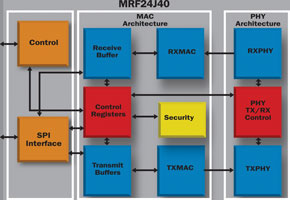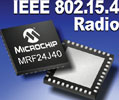
Designed for sensing and control applications, the ZigBee wireless standard is based on the IEEE 802.15.4 standard and was developed by the ZigBee Alliance (www.zigbee.org). The specification addresses the network, security and application layers that are situated on top of the IEEE 802.15.4 low-data-rate wireless personal area network (WPAN) standard.
One of the most important decisions for designers of systems based on the ZigBee protocol is the choice of the radio frequency (RF) transceiver. The factors affecting this choice are many and complex, so it is important that designers first understand the fundamental concepts of the ZigBee standard.
Designers choosing a transceiver need to understand the features of devices from different vendors and the ways in which these features affect the performance of their system. They also need to understand the available development tools tied to these transceivers, to ensure that time to market is minimised.
When selecting a transceiver for use with the ZigBee protocol, it is important to consider the impact of the choice on the complete system and also to think about the features of the transceiver that can offer system enhancements.
It is, of course, important to consider factors such as cost, current and maximum output power when choosing a transceiver, but understanding the features supported by the transceiver can have a large impact on the true system cost.
For example, the maximum length of an IEEE 802.15.4 MAC packet is 127 Bytes, including a 16-bit CRC value that helps to verify the frame integrity. Most transceivers provide built-in CRC modules that automatically calculate these values, filter incoming packets based on a successful CRC, and pad outgoing packets with a correct CRC. In addition, IEEE 802.15.4 optionally uses an acknowledged data-transfer mechanism, in which all frames with a special ACK flag are acknowledged by its receiver. If the frame is transmitted with an ACK flag and the acknowledgement is not received within a specified time, the transmitter will retry the transmission a fixed number of times before declaring an error.
Some transceivers provide automatic transmission of ACK packets to reduce the overhead placed on the system controller by reading, processing and responding to the incoming packet in the short amount of time allowed for a successful acknowledgement. Even fewer transceivers support automatic processing of ACK packets, which can further reduce the host controller overhead.

Automatic MAC retransmission on transmission failure can help to limit the host controller interaction with the transceiver. This removes the burden of having to check and wait for an acknowledgement. Understanding these key differences between different transceivers can save the host controller several KB of program memory, as well as several milliseconds of CPU time per transmitted packet.
Nodes that act as co-ordinators or routers in a network play a vital role in extending the network to reach all the end devices. The output power of these nodes can clearly affect the number of routers required to cover an area. However, a large output power has side effects. Because all the devices on the network share the same channel, every node within a device’s radio range reduces its transmission potential. Routers that do not need to transmit at high power should have their output reduced to the minimum required. This requires a selectable output gain facility on the transceiver.
The other key parameter that affects the number of nodes needed on a network is receiver sensitivity. As with output power, sensitivity has a potential system cost, because increased sensitivity can mean that the node will determine that the channel is busy more frequently, since it can hear more nodes. An adjustable clear-channel assessment threshold feature, when used in conjunction with a lowered output power, can allow transmission of packets locally without causing collisions in the rest of the network.
The ZigBee specification uses an encryption scheme very similar to the IEEE 802.15.3 security suite. Most IEEE 802.15.4 transceivers support the IEEE 802.15.4 encryption modes. This feature is extremely useful in applications where the packets are encrypted, according to the IEEE 802.15.4 specification.
Beyond this, some transceivers support an additional mode in which the security module can be used in a standalone mode, so that it can be re-used for the ZigBee specification security layer requirements. This hardware option can save up to 10 KB of code and several milliseconds of processing, by freeing the microcontroller from encrypting/decrypting the packet in firmware. This simple feature allows applications to save both cost and power by having a microcontroller with a smaller memory and by being able to place the application in a low-power mode sooner.
IEEE 802.15.4 uses carrier sense, multiple access with collision avoidance (CSMA-CA) to access the airwaves. This helps to avoid collisions by checking the channel before transmitting. The CSMA-CA algorithm has a random exponential back-off, when it senses that a collision could occur. This helps to randomise when nodes transmit, to reduce the likelihood of future collisions.

To work effectively, this back-off must be fairly accurate. Without hardware support, this can be a burden on the host controller – both from a code size and a system usage point of view. In systems with a transceiver that does not have built-in support for the CSMA-CA algorithm, the total system current will increase because the host controller is busy servicing and monitoring the RF transceiver, instead of finishing its pending tasks.
Support for the designer is important, to ensure that an effective and robust design can be developed in the minimum amount of time. An easy-to-use stack configuration tool is extremely important, to minimise the size and run-time of the software stack by including only the features that are required by the application. Also, access to the software stack source code can help in understanding how the stack works and what impact it may have on the application. Finally, a full-featured protocol analyser that can decode packets to the highest layers of the stack is important during the development cycle, to debug the system.
Summary
Highly integrated RF transceivers, which require very few external components, can greatly simplify the task of designers developing complete ZigBee protocol platforms. To keep system costs to a minimum, designers should select a transceiver that can work with the wide range of 8- and 16-bit microcontrollers on the market today. The entire system design and the key features of the transceiver that enhance the system should be considered when selecting a transceiver. Finally, having the right tools to develop and debug the system can greatly reduce time to market.
| Email: | [email protected] |
| www: | |
| Articles: | More information and articles about Tempe Technologies |

© Technews Publishing (Pty) Ltd | All Rights Reserved